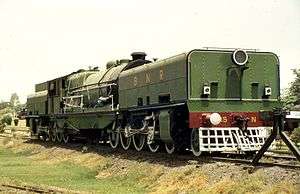Bengal Nagpur Railway
 | |
| Industry | Railways |
|---|---|
| Founded | 1887 |
| Defunct | 1952 (Merged with East Indian Railway Company to form Eastern Railway) |
| Headquarters | Kolkata, India |
Area served | Eastern and Central India |
| Services | Rail transport |
Railways in British India[1]
“As a child of its era, the railway left an indelible mark on the 19th century developments in India. In a country of continental distances, it provided the foundation for modern economic expansion by facilitating the carriage of huge quantities of passengers and freight over very long distances at hitherto unparalleled speeds. During the early part of 20th century, in a growing economy with rapid increase in demand for mobility, railway development was sparked off at a pace similar if not more marked than in Western countries in the 19th century. Development and rapid expansion of railway network in British India served as the backbone for economic growth and industrial development in the post independence era.”


The Bengal Nagpur Railway was one of the companies which pioneered development of the railways in eastern and central India. It was succeeded first by Eastern Railway and subsequently by South Eastern Railway.
History
The opening of the Mumbai-Thane line in 1853 marked the beginning of railways in India. Extension of the railways was set off throughout the country. On the north-eastern side of Mumbai, the Great Indian Peninsular Railway line was extended up to Bhusawal and then split in two. While one track lead to Nagpur, the other to Jabalpur to connect with the East Indian Railway line from Allahabad to Jabalpur, thereby connecting Mumbai and Kolkata. The great famine of 1878 provided an opportunity for the construction of 150 km long meter gauge link called the Nagpur Chhattisgarh Railway in 1882 connecting Nagpur with Rajnandgaon.[2]
The Nagpur Chhattisgarh Railway was owned by the Great Indian Peninsular Railway.[3] Bengal Nagpur Railway was formed in 1887.[4] The Nagpur Chhattisgarh Railway was purchased from Great Indian Peninsula Railway by Bengal Nagpur Railway in 1888, and was converted to broad gauge.[3]
The Bengal Nagpur Railway was formed for the purpose of upgrading the Nagpur Chhattisgarh Line and then extending it via Bilaspur to Asansol, in order to develop a shorter Howrah-Mumbai route than the one via Allahabad.[2] The Bengal Nagpur Railway main line from Nagpur to Asansol was opened for goods traffic on 1 February 1891.[5] It was only after Kharagpur was linked from the west and the south that it was connected to Howrah in 1900.[6]
The civil engineer Lt Col Arthur John Barry was the Executive Engineer in charge of the construction of the bridge over the Damuda River and the work of the Damuda district of the Bengal-Nagpur Railway, of which he was afterwards Superintending Engineer of the Bengal section.[7]
Linking Howrah with Mumbai and Chennai
Although Bengal Nagpur Railway was not a part of original design to connect major points in the subcontinent with a network of railways, it was instrumental in developing a shorter, and hence more popular, route from Howrah to Mumbai and the trunk route from Howrah to Chennai.[2][5][6]
Successors
The Bengal Nagpur Railway was nationalized in 1944.[5]Eastern Railway was formed on 14 April 1952 with the portion of East Indian Railway Company east of Mughalsarai and the Bengal Nagpur Railway.[8] In 1955, South Eastern Railway was carved out of Eastern Railway. It comprised lines mostly operated by BNR earlier.[8][9] Amongst the new zones started in April 2003 were East Coast Railway and South East Central Railway. Both these railways were carved out of South Eastern Railway.[8]
References
- ↑ "The story of Bengal Nagpur Railway (BNR) now South Eastern Railway". Anglo-India-Central. Retrieved 2012-02-19.
- 1 2 3 "Number 1 Down Mail". Railways of the Raj. Retrieved 2012-02-19.
- 1 2 "Nagpur Chhattisgarh Railway". fibis. Retrieved 2012-02-19.
- ↑ "Bengal-Nagpur Railway". fibis. Retrieved 2012-02-19.
- 1 2 3 "Major Events in the Formation of S.E. Railway". South Eastern Railway. Archived from the original on 2013-04-01. Retrieved 2012-02-19.
- 1 2 R.P.Saxena. "Indian Railway History timeline". Retrieved 2012-02-19.
- ↑ Frederick Arthur Crisp Visitation of England and Wales, Volume 14, London (1906)
- 1 2 3 "Geography – Railway Zones". IRFCA. Retrieved 2012-11-21.
- ↑ "IR History: Part - IV (1947 - 1970)". IRFCA. Retrieved 2012-11-21.